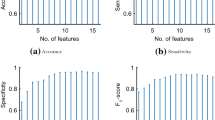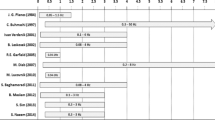Abstract
Preterm birth (gestational age < 37 weeks) is a public health concern that causes fetal and maternal mortality and morbidity. When this condition is detected early, suitable treatment can be prescribed to delay labour. Uterine electromyography (uEMG) has gained a lot of attention for detecting preterm births in advance. However, analyzing uEMG is challenging due to the complexities associated with inter and intra-subject variations. This work aims to investigate the applicability of cyclostationary characteristics in uEMG signals for predicting premature delivery. The signals under term and preterm situations are considered from two online datasets. Preprocessing is carried out using a Butterworth bandpass filter, and spectral correlation density function is adapted using fast Fourier transform-based accumulation method (FAM) to compute the cyclostationary variations. The cyclic frequency spectral density (CFSD) and degree of cyclostationarity (DCS) are quantified to assess the existence of cyclostationarity. Features namely, maximum cyclic frequency, bandwidth, mean cyclic frequency (MNCF), and median cyclic frequency (MDCF) are extracted from the cyclostationary spectrum and analyzed statistically. uEMG signals exhibit cyclostationarity property, and these variations are found to distinguish preterm from term conditions. All the four extracted features are noted to decrease from term to preterm conditions. The results indicate that the cyclostationary nature of the signals can provide better characterization of uterine muscle contractions and could be helpful in detecting preterm birth. The proposed method appears to aid in detecting preterm birth, as analysis of uterine contractions under preterm conditions is imperative for timely medical intervention.






Similar content being viewed by others
References
Huey JR. Uterine activity monitoring: for evaluation of progress in labor. Postgrad Med. 1977;61:149–54.
Garcia-Casado J, Ye-Lin Y, Prats-Boluda G, Mas-Cabo J, Alberola-Rubio J, Perales A. Electrohysterography in the diagnosis of preterm birth: a review. Physiol Meas. 2018;39:02TR01.
Walani SR. Global burden of preterm birth. Int J Gynecol Obstet. 2020;150:31–3.
Garfield RE, Maner WL. Physiology and electrical activity of uterine contractions. Semin Cell Dev Biol. 2007;18:289–95.
Wolfs GMJA, van Leeuwen M. Electromyographic observations on the human uterus during labour. Acta Obstet Gynecol Scand. 1979;58:1–61.
Cohen WR. Clinical assessment of uterine contractions. Int J Gynecol Obstet. 2017;139:137–42.
Euliano TY, Nguyen MT, Darmanjian S, McGorray SP, Euliano N, Onkala A, et al. Monitoring uterine activity during labor: a comparison of 3 methods. Am J Obstet Gynecol. 2013;208:66 e1.
Vrhovec J, Macek A. An uterine electromyographic activity as a measure of labor progression. Applications of EMG in Clinical and Sports Medicine. 2012:243-68.
Marque C, Duchene JMG, Leclercq S, Panczer GS, Chaumont J. Uteine EHG processing for obstetrical monitoring. IEEE Trans Biomed Eng. 1986;12:1182-7.
Fele-Žorž G, Kavšek G, Novak-Antolič Ž, Jager F. A comparison of various linear and non-linear signal processing techniques to separate uterine EMG records of term and pre-term delivery groups. Med Biol Eng Comput. 2008;46:911–22.
Sim S, Ryou H, Kim H, Han J, Park K. Evaluation of electrohysterogram feature extraction to classify the preterm and term delivery groups. In 15th International Conference on Biomedical Engineering. 2014; 675–8.
Selvaraju V, Karthick PA, Swaminathan R. Analysis of frequency bands of uterine electromyography signals for the detection of preterm birth. In MIE. 2021; 283–287
Xu J, Chen Z, Lou H, Shen G, Pumir A. Review on EHG signal analysis and its application in preterm diagnosis. Biomed Signal Process Control. 2022;71: 103231.
Alamedine D, Khalil M, Marque C. Parameters extraction and monitoring in uterine EMG signals. Detection of Preterm Deliveries. IRBM. 2013;34:322–5.
Namadurai P, Padmanabhan V, Swaminathan R. Multifractal analysis of uterine electromyography signals for the assessment of progression of pregnancy in term conditions. IEEE J Biomed Health Inform. 2019;23:1972–9.
Punitha N, Vardhini P, Vinothini S, Ramakrishnan S. Analysis of fluctuations of uterine contractions in preterm pregnancies using adaptive fractal features of electromyography signals. Fluct Noise Lett. 2021;20:2150019.
Selvaraju V, Namadurai P, Swaminathan R, Analysis of electromyography burst signals using topological feature extraction for diagnosis of preterm birth. IEEE signal processing in medicine and biology symposium (SPMB). 2020; 1–4.
Vinothini S, Punitha N, Karthick PA, Ramakrishnan S. Automated detection of preterm condition using uterine electromyography based topological features. Biocybern Biomed Eng. 2021;41:293–305.
Divya Bharathi K, Karthick PA, Ramakrishna S. Automated detection of muscle fatigue conditions from cyclostationary based geometric features of surface electromyography signals. Comput Methods Biomech Biomed Eng. 2021;25:320–32.
Selvaraju V, Pa K, Spectral SR, Density C, based electrohysterography signal analysis for the detection of preterm birth. IEEE international symposium on medical measurements and applications (MeMeA). 2022; 1–5.
Ambrosanio M, Baselice F. Cyclostationary analysis for heart rate variability. Open Bioinforma J. 2018;11:164–81.
Mihandoost S, Amirani MC. EEG signal analysis using spectral correlation function & GARCH model. Signal Image Video P. 2015;9:1461–72.
Mihandoost S, Chehel AM. Cyclic spectral analysis of electrocardiogram signals based on GARCH model. Biomed Signal Process Control. 2017;31:79–88.
Karthick PA, Venugopal G, Ramakrishnan S. Analysis of muscle fatigue progression using cyclostationary property of surface electromyography signals. J Med Syst. 2016;40:1–11.
Seydnejad S. Detection of nonlinearity in cardiovascular variability signals using cyclostationary analysis. Ann Biomed Eng. 2007;35:744–54.
Yu L, Yan L, Chen M, Dong L. Cyclostationary modeling of surface electromyography signal during gait cycles and its application for cerebral palsy diagnosis. J Shanghai Jiaotong Univ (Sci). 2018;23:56–61.
Haritopoulos M, Roussel J, Capdessus C, Nandi AK. Cyclostationarity-based estimation of the foetus subspace dimension from ecg recordings. In XIII Mediterranean Conference on Medical and Biological Engineering and Computing. 2014; 726–9.
Jager F, Libenšek S, Geršak K. Characterization and automatic classification of preterm and term uterine records. PLoS ONE. 2018;13:e0202125.
Jager F, Geršak K, Vouk P, Pirnar Ž, Trojner-Bregar A, Lučovnik M, et al. Assessing velocity and directionality of uterine electrical activity for preterm birth prediction using EHG surface records. Sensors. 2020;20:7328.
Mas-Cabo J, Prats-Boluda G, Perales A, Garcia-Casado J, Alberola-Rubio J, Ye-Lin Y. Uterine electromyography for discrimination of labor imminence in women with threatened preterm labor under tocolytic treatment. Med Biol Eng Comput. 2019;57:401–11.
Verdenik I, Pajntar M, Leskošek B. Uterine electrical activity as predictor of preterm birth in women with preterm contractions. Eur J Obstet Gynecol Reprod Biol. 2001;95:149–53.
Lessard CS. Signal processing of random physiological signals. Morgan & Claypool Publishers, 2006.
Welch P. The use of fast Fourier transform for the estimation of power spectra: a method based on time averaging over short, modified periodograms. IEEE Trans Audio Electroacoust. 1967;15:70–3.
Rabotti C, Mischi M, van Laar JOEH, Oei GS, Bergmans JWM. Estimation of internal uterine pressure by joint amplitude and frequency analysis of electrohysterographic signals. Physiol Meas. 2008;29:829–41.
Xu J, Wang M, Zhang J, Chen Z, Huang W, Shen G, et al. Network theory based EHG signal analysis and its application in preterm prediction. IEEE J Biomed Health Inform. 2022;26:2876–87.
Karthick PA, Ghosh DM, Ramakrishnan S. Surface electromyography based muscle fatigue detection using high-resolution time-frequency methods and machine learning algorithms. Comput Methods Programs Biomed. 2018;154:45–56.
Choi H-I, Williams WJ. Improved time-frequency representation of multicomponent signals using exponential kernels. IEEE Trans Acoust, Speech, Signal Process. 1989;37:862–71.
Gardner WA, Napolitano A, Paura L. Cyclostationarity: Half a century of research. Signal Process. 2006;86:639–97.
Roussel J, Haritopoulos M, Ravier P, Buttelli O. Cyclostationary analysis of electromyographic signals. European Signal Processing Conference (EUSIPCO 2013). 2013;1–5.
Li T, Qiu T, Tang H. Optimum heart sound signal selection based on the cyclostationary property. Comput Biol Med. 2013;43:607–12.
Da Costa EL. Detection and identification of cyclostationary signals. PhD diss., Naval Postgraduate School, 1996.
George GR, Prema SC. Cyclostationary feature detection based blind approach for spectrum sensing and classification. Radioengineering. 2019;27:298–303.
Marshall S, Vanhoy G, Akoglu A, Bose T, Ryu B. GPU Based quarter spectral correlation density function. IEEE Conference on Design and Architectures for Signal and Image Processing (DASIP). 2018; 88–93.
Tarek K, Abderrazek D, Khemissi BM, Cherif DM, Lilia C, Nouredine O. Comparative study between cyclostationary analysis, EMD, and CEEMDAN for the vibratory diagnosis of rotating machines in industrial environment. Int J Adv Manuf Technol. 2020;109:2747–75.
Garfield RE, Maner WL, MacKay LB, Schlembach D, Saade GR. Comparing uterine electromyography activity of antepartum patients versus term labor patients. Am J Obstet Gynecol. 2005;193:23–9.
Acknowledgements
The authors are grateful to Physiobank for providing the Term-Preterm ElectroHysteroGram database (physionet.org/content/tpehgdb/1.0.1/) and Term-Preterm ElectroHysterogram with Tocogram dataset (physionet.org/content/tpehgt/1.0.0/).
Funding
The authors state that they did not receive any grants, funding, or other assistance for preparing this manuscript.
Author information
Authors and Affiliations
Contributions
Vinothini S.—Conceptualization, Methodology, Software, Validation, Investigation, Writing—original draft, Writing—review & editing, Visualization. Punitha N—Conceptualization, Methodology, Investigation, Validation, Writing—original draft, Writing—review & editing. Karthick P.A—Investigation, Visualization. Ramakrishnan S—Investigation, Supervision.
Corresponding author
Ethics declarations
Conflict of interests
The authors do not have any applicable financial/non-financial interest to declare.
Ethical approval
As this study uses the data from publicly available online datasets for analysis, ethics approval is not applicable.
Consent to participate
As this study uses the data from publicly available online datasets for analysis ‘consent to participate’ is not applicable.
Consent to publish
As this study uses the data from publicly available online datasets for analysis, ‘consent to publish’ is not applicable.
Additional information
Publisher's Note
Springer Nature remains neutral with regard to jurisdictional claims in published maps and institutional affiliations.
Rights and permissions
Springer Nature or its licensor (e.g. a society or other partner) holds exclusive rights to this article under a publishing agreement with the author(s) or other rightsholder(s); author self-archiving of the accepted manuscript version of this article is solely governed by the terms of such publishing agreement and applicable law.
About this article
Cite this article
Vinothini, S., Punitha, N., Karthick, P.A. et al. Cyclostationary analysis of uterine EMG measurements for the prediction of preterm birth. Biomed. Eng. Lett. (2024). https://doi.org/10.1007/s13534-024-00367-2
Received:
Revised:
Accepted:
Published:
DOI: https://doi.org/10.1007/s13534-024-00367-2




